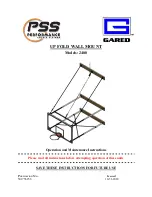
3
Digging the Hole
Installation Time
This will vary depending on trampoline size, equipment used and soil conditions. The Oz Trampolines
In-ground Trampolines have been designed to minimise the need to excavate too much soil.
If you have a mini-digger, then the hole excavation will only take a couple of hours. If you’re hand digging,
then allow a full day for 2-4 people to dig the hole, assemble the trampoline and do the finishing landscaping.
Every hole construction will vary in respect of size of trampoline, soil conditions and drainage requirements.
Equipment needed
For the smaller 11ft x 8ft size trampoline, it’s a relatively easy task to hand dig the hole. For the larger 14ft x10ft
size, it’s quicker and easier to hire a mini digger (and operator). The mechanical digger should be able to
excavate most of the soil to leave you with the hand finishing. You will also need a cross-head screwdriver and
protective gloves & googles.
Trampoline Size
Inner Hole Diameter
Hole Depth (D)
11ft (3.35m) x 8ft (2.45m)
9ft (2.75m) x 6ft (1.85m)
75cm
14ft (4.25m) x 10ft (3m)
12ft (3.65m) x 8ft (2.45m)
90cm
Hole Dimensions for Rectangular Trampolines
4
Digging the Hole
Step 1
To begin, mark out your required hole. It’s best to mark out a rectangle around 10cm wider than the measurements
of your trampoline. This will make it easier for you to put the frame in and find the right level. It’s very difficult to
dig an exact hole and this gives you some tolerance. At the end of the install you back-fill around the outside of
the hole with soil you have saved and re-turf.
Step 2
The next step is to start digging the main hole for your trampoline frame and retaining wall.This needs to be
25cm deep, which is the right frame height. The vented pads sit on top of the frame so they will be just above
the grass level.
Step 3
The next stage is to dig the inner hole so that the trampoline will be safe for jumping. Dig this out in a bowl shape
to a depth of 75cm (11ft x 8ft trampoline), or 90cm (14ft x 10ft trampoline). The inner hole is 50cm narrower in
diameter than the trampoline size. This will leave a 25cm ledge all around on which the trampoline sits.
Step 4
If you have well-drained or sandy soil, then you will not need to consider any further drainage. For less porous
soil or clay, we suggest you put in a soak-away at the bottom of the inner hole, or connect it to your storm
water pipe where possible.
Step 5
We suggest you line the hole with a weed matting to prevent weeds growing. The weed matting needs to be
permeable to allow water to soak through. The matting can be anchored on the ledge under the bottom frame.
Step 6
The best and cheapest option is to try and lose the soil or create a feature in your garden. If you want to get
rid of the soil off-site, then a skip is a good solution, but you will need a large skip as soil expands when you
dig it out.
The In-ground Trampoline Kit has been designed for ease of installl with DIY in mind. If however you have
any doubts, then please contact us or one of our recommended garden landscaper/contractors to assist
and advise you. See www.oztrampolines.com.au for further information.
Содержание Rectangular In-Ground Trampoline
Страница 1: ......



























